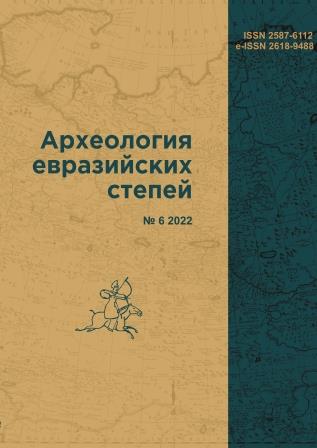Magnetometrical Studies of the Golden Horde Sites in the Lower Volga Region
DOI:
https://doi.org/10.24852/2587-6112.2022.6.144.154Keywords:
archaeology, Golden Horde, Selitrennoye settlement, Lapas complex, furnace, mausoleum, magnetometryAbstract
The use of non-contact methods of studying archaeological monuments of a large area is considered in the paper. It presents the results of magnetometrical studies on the Selitrennoye settlement (Sarai al-Jedid city is the capital of the Golden Horde) and on the Lapas complex, that is a necropolis of the Golden Horde aristocracy. The comparative analysis shows the results of aerial photography and topographical survey of archaeological sites. Variants of decryption of magnetometry data and the results of verification of these data by archaeological methods are proposed. The authors recommend the use of magnetometrical studies in the implementation of projects for the museumification of archaeological sites.
References
Ballod, F. V. 1923. Stariy i Noviy Saray, stolitsy Zolotoy Ordy (Old and New Sarai, Capitals of the Golden Horde). Kazan: “Kombinat Izdatel'stva i Pechati v Kazani” Publ. (in Russian).
Bezdudniy V.G., Pigarev E.M. 2010. In Kurapov, A. A. (ed.). Astrakhanskie kraevedcheskie chteniya (Astrakhan Local History Readings) II. Astrakhan: “Sorokin Roman Vasil'evich” Publ., 100–105 (in Russian).
Golod, A. A. 2001. In Burkhanov, A. A. (ed.). Dialog kul’tur Evrazii: Voprosy srednevekovoi istorii i arkheologii. Izuchenie i sokhranenie istoriko-kul’turnogo naslediia (Dialogue of Eurasian Cultures. Issues of Medieval History and Archaeology. Study and Conservation of the Historical and Cultural Heritage) 2. Kazan: Tatar State Institute for Humanities, 154–159 (in Russian).
Egorov, V. L. 1985. Istoricheskaia geografiia Zolotoi Ordy v XIII–XIV vv. (Historical Geography of the Golden Horde in the 13th—14th Centuries). Moscow: “Nauka” Publ. (in Russian).
Pigarev, E. P. 1997. In Tezisy dokladov pervogo mezhdunarodnogo simpoziuma «Osobo okhranyaemye territorii i formirovanie zdorovogo obraza zhizni» (Volgograd, 8−14 sentyabrya 1997 g.). (Abstracts of the papers at the first international symposium "Specially protected areas and the formation of the health promotion" (Volgograd, September 8-14, 1997).Volgograd: Press and Information Committee, 21–22 (in Russian).
Pigarev, E. M. 2019. Selitrennoe gorodishche: istoriya issledovaniy (Selitrennoe settlement: the history of research). Series: Materialy i issledovaniya po arkheologii Povolzh'ya (Materials and Research on the Archaeology of the Volga Region) 11. Yoshkar-Ola: Mari State University (in Russian).
Chekalin F.F. 1889. In Trudy Saratovskoy uchenoy arkhivnoy komissii (Proceedings of the Saratov Scientific Archival Commission) 2 (1). Saratov, 2, 81 (in Russian).
Chelebi, E. 1979. Kniga puteshestviya. Izvlecheniya iz sochineniya turetskogo puteshestvennika XVII veka. Vyp. 2. Zemli Severnogo Kavkaza, Povolzh'ya i Podon'ya (Book of Travel. Extracts from a Work by a 17th Century Turkish Traveler.Lands of Northern Caucasus, the Volga and Don Areas. Vol. 2. Moscow: “Nauka” Publ. (in Russian).

Downloads
Published
How to Cite
Issue
Section
License
Copyright (c) 2022 V.G. Bezdudny, E.M. Pigarev, A.G. Sitdikov

This work is licensed under a Creative Commons Attribution-NonCommercial 4.0 International License.







